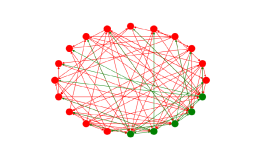Associate Professor Stanislav Mintchev Co-Published In Mathematical Modelling Of Natural Phenomena
POSTED ON: May 17, 2024

Figure 2 from the publication: a representative diagram of a network under consideration.
Associate Professor of Mathematics Stanislav Mintchev has co-published in Mathematical Modelling of Natural Phenomena (Vol. 19, 2024). The paper delves into the topic of “Emergent properties in a V1-inspired network of Hodgkin–Huxley neurons.”
For additional information regarding this publication, please click here.
ABSTRACT
This article is devoted to the theoretical and numerical analysis of a network of excitatory and inhibitory neurons of Hodgkin–Huxley (HH) type, for which the topology is inspired by that of a single local layer of visual cortex V1. Our model relies on recent work in this area and thus combines a stochastic drive – which may be interpreted as an ambient drive for each neuron – with recurrent inputs resulting from the network activity. After a review of the dynamics of a single HH equation for both the deterministic and the stochastically driven case, we proceed to an analysis of the network. This analysis reveals emergent properties of the system such as partial synchronization and synchronization (defined here as a state of the network for which all the neurons spike within a short interval of time), correlation between excitatory and inhibitory conductances, and oscillations in the Gamma-band frequency. The collective behavior enumerated herein is observed when the input-amplitude parameter SEE measuring excitatory-to-excitatory coupling (recurrent excitation) increases to within a certain range. Of note, our work indicates a distinct mechanism for obtaining the emergent properties, some of which have been classically observed. As a consequence our article contributes to the understanding of how assemblies of inhibitory and excitatory cells interact together to produce rhythms in the network. It also aims to bring problems from neuroscience to the realm of mathematics, where they can be analyzed rigorously.




